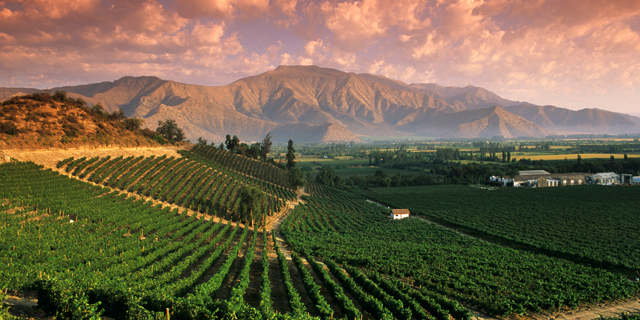Only Pablo Neruda could look at a glass of wine and see the curves of a woman’s body. We can only speculate, but it’s possible Neruda was sipping a glass of Carmenère while composing the lines of his wildly romantic poem, “Ode to Wine.”
Although Carmenère is one of Chile’s most renowned wines, for a while it suffered from an identity crisis, as it was mistaken for Merlot. Originally from France’s Bordeaux region, the grape was nearly obliterated by phylloxera, the root louse that devastated France’s vineyards in the late 1800s. Experts believe that cuttings of Carmenère were mixed with Merlot in shipments to Chile.
It wasn’t until 1994 that DNA testing revealed the truth. Most of what Chilean winemakers believed to be Merlot vines were actually Carmenère. You can’t blame them for the mix-up, since Merlot and Carmenère vines look similar. One distinguishing characteristic is that Carmenère leaves look red underneath when they’re young, which is why some believe the name Carmenère derives from the word ‘carmine.’
A late-ripening grape, Carmenère grows best in sunny, warm vineyards. If picked too early, the wine’s characteristic green pepper aromas may become too dominant. When selecting Carmenère, ask the sommelier or wine merchant for a wine from a warmer vintage or from a reputable producer. Carmenère is often blended with Cabernet Sauvignon and Merlot. Here are some tips to help you find your own version of Chilean poetry in a bottle:
Label Lingo
Choose wines from Chile’s Aconcagua sub-region, which has some of the warmest vineyard sites in the country. Carmenère from this region may display riper fruit. Chile’s Central Valley produces some of the more budget-friendly wines. Look for Carmenère grown in the Cachapoal zone of the Central Valley.
Taste
Dry with well-structured tannins, you’ll notice ripe blackberry and plum aromas with a touch of pepper. This is not a very acidic wine, but it has a distinct sweet-and-savory flavor. Mature Carmenère will display mocha, chocolate, and meaty aromas with a trace of smokiness and dried roses.
Pairings
Pork, barbecued meats, game, lamb. Try it with: Cochinita Pibil, Grilled Skirt Steak with Argentinean Chimicurri, Ecuadorian Lamb Stew, Chuletas de Cordero (lamb chops).
Recommendations
Concha y Toro, Montes, Almaviva, De Martino, Gracia, Luis Felipe Edwards.


![Making Mealtime Matter with La Familia: Easy Sofrito [Video]](https://thelatinkitchen.com/wp-content/uploads/2015/10/sofrito-shutterstock__0-500x383.jpg)
![Easy Latin Smoothies: Goji Berry Smoothie [Video]](https://thelatinkitchen.com/wp-content/uploads/2015/12/goji_berry-shutterstock_-500x383.jpg)
















![Fun and Fast Recipes: Fiesta Cabbage Salad [Video]](https://thelatinkitchen.com/wp-content/uploads/2015/11/fiesta_cabbage_slaw-shutterstock_-500x383.jpg)









